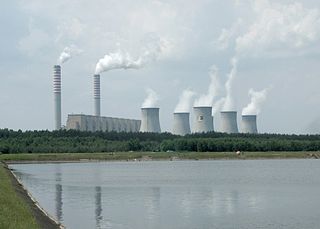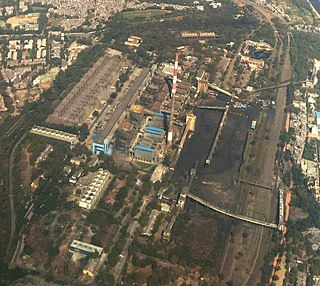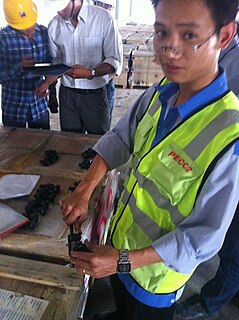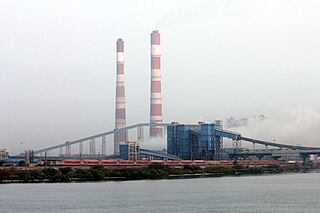
A fossil fuel power station is a thermal power station which burns a fossil fuel such as coal, natural gas, or petroleum to produce electricity. Central station fossil fuel power plants are designed on a large scale for continuous operation. In many countries, such plants provide most of the electrical energy used. Fossil fuel power stations have machinery to convert the heat energy of combustion into mechanical energy, which then operates an electrical generator. The prime mover may be a steam turbine, a gas turbine or, in small plants, a reciprocating internal combustion engine. All plants use the energy extracted from expanding gas, either steam or combustion gases. Although different energy conversion methods exist, all thermal power station conversion methods have efficiency limited by the Carnot efficiency and therefore produce waste heat.

A thermal power station is a power station in which heat energy is converted to electric power. In most of the places in the world the turbine is steam-driven. Water is heated, turns into steam and spins a steam turbine which drives an electrical generator. After it passes through the turbine, the steam is condensed in a condenser and recycled to where it was heated; this is known as a Rankine cycle. The greatest variation in the design of thermal power stations is due to the different heat sources; fossil fuel dominates here, although nuclear heat energy and solar heat energy are also used. Some prefer to use the term energy center because such facilities convert forms of heat energy into electrical energy. Certain thermal power stations are also designed to produce heat energy for industrial purposes, or district heating, or desalination of water, in addition to generating electrical power.

Plomin Power Station is a coal-fired power station near Plomin, Croatia. As of 2007, its production corresponded to 13% of Croatia's electricity needs.
Korea Electric Power Corporation, better known as KEPCO or Hanjeon, is the largest electric utility in South Korea, responsible for the generation, transmission and distribution of electricity and the development of electric power projects including those in nuclear power, wind power and coal. KEPCO is responsible for 93% of Korea's electricity generation. The South Korean government owns a 51.11% share of KEPCO. Together with its affiliates and subsidiaries, KEPCO has an installed capacity of 65,383 MW. On the 2011 Fortune Global 500 ranking of the world's largest companies, KEPCO was ranked 271. KEPCO is a member of the World Energy Council, the World Nuclear Association and the World Association of Nuclear Operators. As of August 2011, KEPCO possesses an A+ credit rating with Fitch Ratings, while Moody's has assigned KEPCO an A1 stable rating.
The Hwange Thermal Power Station is the biggest power plant in Zimbabwe with an installed capacity of 920 MW. It is owned and driven by the national electricity company ZESA Holdings (Pvt) LTD.
Nashik Thermal Power Plant is located at Eklahare village near Nashik in Maharashtra. The power plant is one of the coal based power plants of Maharashtra State Power Generation Company (Mahagenco)

Badarpur Thermal Power Station is located at Badarpur area in NCT Delhi. The power plant is one of the coal based power plants of NTPC. The National Power Training Institute (NPTI) for North India Region under Ministry of Power, Government of India was established at Badarpur in 1974, within the Badarpur Thermal power plant (BTPS) complex. The power plant permanently shut down on 15 October 2018.

Łagisza Power Station is a coal-fired thermal power station at Łagisza in Będzin, Poland. The power plant has a total installed power capacity of 1,060 MW and installed cogeneration thermal capacity of 335 MW. It is operated by Południowy Koncern Energetyczny, a subsidiary of the Tauron Group.
NTPC Limited, formerly known as National Thermal Power Corporation Limited, is an Indian Public Sector Undertaking, engaged in the business of generation of electricity and allied activities. It is a company incorporated under the Companies Act 1956 and is promoted by the Government of India. The headquarters of the company is situated at New Delhi. NTPC's core business is generation and sale of electricity to state-owned power distribution companies and State Electricity Boards in India. The company also undertake consultancy and turnkey project contracts that involve engineering, project management, construction management and operation and management of power plants.
Rosa Power Plant is a 1,200 MW of coal based generation capacity at Rosa village in Shahjahanpur, Uttar Pradesh.

The Ennore Thermal Power Station is a coal based power plant located in Chennai Ennore, Tamil Nadu.
Sri Damodaram Sanjeevaiah Thermal Power Station is located in Nelatur Village, near Krishnapatnam and at a distance of 23 km from Nellore city of Andhra Pradesh. The power plant is one of the coal-based power plants of Andhra Pradesh Power Development Company Limited (APPDCL). It is the Special Purpose Vehicle (SPV), a joint venture company of APGENCO and IL AND FS partnership.
Mông Dương is a ward of Cẩm Phả city, in Quảng Ninh Province, Vietnam. It is the site of the Mông Dương thermal power plant projects designed to reduce Vietnam's dependence on hydropower.

The Duyên Hải Power Station is a complex of under-construction coal-fired power plants in Vietnam. It is located in Mu U Hamlet, Dan Thanh Commune, Duyên Hải District, Trà Vinh Province. The complex will have a total capacity of 3,689 MW. It includes also a seaport coal terminal, to be built by China Communications Construction Company, with a capacity of 12 million tonnes of coal and oil per year.
Bellary Thermal Power station is located in Kudatini Village, Bellary District in the Indian state of Karnataka. Two coal-fired units of 500 MW each are in operation with generating capacity of 12 million units per day and a 700 MW coal-fired unit with operation The thermal electric power generating station is run by KPCL a government of Karnataka undertaking. This electric generating plant is located at Kudatini village on Hosapete - Ballari road.

Vallur Thermal Power Station is a power plant located in Athipattu Pudunagar, Vallur in Thiruvallur district, North Chennai, India. The power plant is operated by NTPC Tamil Nadu Energy Company Limited, a joint venture between NTPC Limited and TANGEDCO and has three units with 500 MW each.
Butibori Power Project is a coal-based thermal power plant located at Butibori near Nagpur in the Indian state of Maharashtra. The power plant is operated by the Reliance Power.
The Singareni Thermal Power Plant (STPP) is a coal-fired power station in Pegadapalli, a village in Telangana, India. The power plant has an installed capacity of 1200 MW, consisting of two 600 MW units, and is operated by the Singareni Collieries Company.











